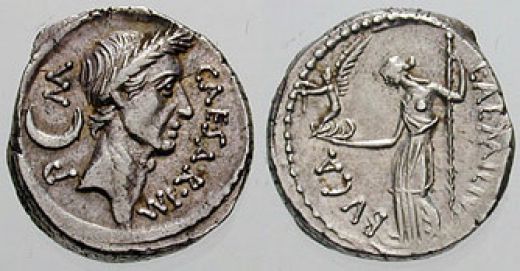
The Origins of Christianity
By Ralph Perrier
I will not presume to speak of anything except what Christ has accomplished through me in leading the Gentiles to obedience by word and deed - Romans 15:18
Contents
Preface
Introduction
1 Name and Title Meanings
2 Alexander the Great
3 Julius Caesar aka Asander of Bosphorus
4 Rome on the Bosphorus?
5 Flavian Dynasty
6 Julius Caesar was a Title
7 Esus the Celtic Deity
8 Subversion of the Imperial Cult
Conclusion
Appendix A: The Symbol of the Cross
Appendix B: How did Christianity Spread?
Further reading
Footnotes
To maintain control over their subjects, imperial powers in antiquity employed a variety of strategies as part of their colonial program, including the creation of slave-morality cults, fictional stories, faked deaths and adoptions, and an endless series of regional aliases, to subjugate a population to their aristocratic rule and to prevent rebellions. In Sumer, the rulers were all priests, whereas in Egypt, the Pharaohs claimed to be sons of gods. It was in Egypt with Atenism, which was a religion to deify Pharaoh Akhenaten, where monotheism first emerged. The collectivization of divine authority with monotheism reinforces a universal morality and everything becomes collectivized with the centralization of power. This makes a group easier to control and is why monotheism mirrors autocratic governance. The Persians also deified their leaders, promoted monotheism (Zoroastrianism), and even took it a step further by incorporating a very powerful slave-morality religion into their imperial cult as part of their colonial program. They created Buddhism, with Gautama Buddha being Gaumata Bardya, also known as Smerdis, the son of Cyrus the Great, who governed the Persian province of Bactra. The Greeks followed this formula with the Ptolemaic cult of Alexander and the Serapis cult. Serapis was a universal composite deity created by blending the Egyptian gods Osiris and Apis with the Greek god Zeus (and others) to resonate with the multicultural society that Ptolemy I envisioned for Egypt. The Romans adopted this formula and established their own imperial cults. These imperial powers maintained their empires through religious syncretism and slave-morality religions, which stripped the population of their will to power. Christianity is a relic of one of these imperial slave moralities, which itself was subverted by a confederation of rabbis after the Bar Kokhba Revolt (132–136 CE).
Note on aliases: I believe that the royal elites in antiquity role-played as if they were characters in a play, and they used regional aliases and fictional deaths as story patterns or archetypes. They killed off one character and then assumed the role of another one in a different location. For example, the governor of Roman Egypt from 33 CE to 38, Aulus Avillius Flaccus, was also Polemon II of Pontus, who was the prince of the Bosporan, Pontus, Cilicia, and Cappadocia, which was the regional alias of Emperor Titus. The character of Aulus Avillius Flaccus dies at the same time Polemon II of Pontus takes power, and then Polemon II of Pontus dies around the same time Titus becomes emperor. The way of connecting them is through the fact that they were all married to the same woman, Berenice, granddaughter of King Herod. The numerous aliases they used could also hide the fact that these royal elites were heavily into incest which would have repulsed the population.
Note on locations: After a year of research, I believe that much of what we know about history from antiquity is fabricated. I have come to the conclusion that the Greco-Egyptian Ptolemaic Kingdom did not end at the point of Roman colonization, it just spread out and Ptolemaic kings adopted regional aliases. The Church Fathers, the Vatican, the Jesuits and people like Joseph Justus Scaliger, who was the Jesuit priest who “discovered” the majority of texts from antiquity that we use today, usually on demand, and Poggio Bracciolini, who was the individual responsible for collecting documents for him, further added to the distortion of historical records. This manipulation of historical facts has led to a distorted understanding of the past, and it is likely that many events, dates, and figures have been altered or fabricated to serve the interests of the Church and other powerful institutions.
This book challenges mainstream historiography. My methodologies are: archaeological and numismatic evidence, linguistic and etymological analysis, historical correlation and timeline analysis. The sources that inspired my work are listed in the ‘Further reading’ section at the end of the book.
A non-mainstream version of history, but one that is recorded in the Persian Book of Kings, the Alexander Romance, and Islamic sources, is that Alexander the Great was a Persian prince who was the son of Artaxerxes II Memnon (“Kai Bahman”) and half-brother of Darius III (“Darab”). No one today is taught that such a relationship was even remotely possible in ancient times, much less taken as gospel in certain parts of the world. Nevertheless, the case can readily be made that the little kingdom of Macedon had been part of the Persian Empire from the time of Darius the Great. In fact, the very first Persian-appointed overseer of Macedon had the Persian name Bubares son of Megabyzus, and subsequent kings of Macedon are said to have descended from him. It is certainly no mystery that Egypt had become a Persian province. Alexander’s rapid and even enthusiastic acceptance in Babylon, Egypt, and Persia demonstrates that his legitimacy was not questioned anywhere within the Empire and its so-called tributary states.
In the book the Alexander Romance, a book that has its earliest copy dating back a couple of centuries after his life, Alexander accepts mortality only after achieving complete satisfaction in his conquests. In the so-called apocryphal accounts Alexander sails up the Ganges River and reaches a kind of Paradise after the conquest of all India is complete. He is not literally granted eternal life there, but nevertheless fulfills his goal of reaching this remote and privileged locale. In the Romance, Alexander also lives to play a part in the lives of the next generation of princes, who have grown to maturity and are even married when he visits them in the south of Egypt.
The conqueror of the Indian sub-continent is known by a different name, Chandra-Gupta, one of the most celebrated kings of all of Indian history. Curiously, almost nothing is known about his early life until after the death of Alexander the Great. No sooner did the attempted conquest of Alexander end than that of Chandragupta began. The name Chandra Gupta can be interpreted as “Alexander the Copt/ Upper Egyptian” as Gupta has been linguistically associated with Coptos (a Greek word for a critical locale in Upper Egypt), and Chandra is a transliteration of Sander (a hypocorism of Alexander/ Iksander). There is a claim by ancient rulers of Bukhara/ Bochara on the Silk Road (in Sogdiana) that they were descended from Alexander – a claim which becomes far more credible (and even inevitable) when one realizes that Alexander’s life did not end in Babylon and his dynastic line did not actually die out.
The groundwork for Christianity traces back to the Cult of Alexander. “Jesus” (Ye-Zeus (YHWH + Zeus), I(J)upiter-Zeus, Zeus-Amun, Zeus-Ahura Mazda, Zeus-Yahweh, et.al., were titles Alexander carried) then became an avatar for his direct descendants in an imperial cult, including Ptolemy XII Auletes/Ptolemy X Alexander I, king of Egypt aka Mithridates VI Eupator aka Ariarathes VII of Cappadocia, et.al., and his son Asander (obvious reference to Alexander), King of Bosphorus aka Pharnaces II aka Brogitarix, king of Galatia aka Ariarathes IX aka Julius Caesar.
Endnotes (Chapter 2)
(a) The jews declared Alexander a messiah, or “The Anointed One” (Chréstos/Soter) (Josephus. Antiquities, XI. 8. Talmud, Yoma 67b) because he “liberated” them from the Persians in 330 BC. Paradoxically, the Jews did the same with Cyrus the Great when he in turn “liberated” them from the Babylonians. The Jews also told Alexander the Great that the book of Daniel was a prophecy about him (it wasn’t, they wrote it after they met him). The Book of Daniel “prophesied” of Alexander the Great of Greece conquering the whole world even Israel. He was called the Ram of God by Prophet Daniel and in Daniel 8:5-7 a male goat with a large horn between his eyes suddenly arises from the west and smashes both horns of the ram. The angel Gabriel tells Daniel this goat represents the kingdom of Greece and its large horn is its first king. Also, according to the first-century A.D. historian Plutarch, Alexander’s mother Olympias told her son that he had been conceived when a thunderbolt – interpreted as Zeus – entered her womb, so he was divinely birthed. He died at 33. ‘The Son of the Man’ is a Koine->Aramaic->Koine mistranslation of Alexander and he was the “King of Kings”.
(b) Other evidence of this is theory that the Sanskrit language might be a dialect of Avestan, or a Hellenized variant of Avestan, and the similarities of customs and religions. Also, there is strong evidence that Alexander’s successor to Bactria, Diodotus I Soter, ruled India with the regional identity of Ashoka the Great. See: Alexander Romance. The life of Alexander of Macedon.\
(c) British scholars (like William Jones) wrongly linked “Sandrocottus” (from Greek texts) to Chandragupta Maurya. Who was the real “Sandrocottus”? Seleucus I Nicator (Alexander’s general, ruler of Babylon). Chandragupta (Alexander) married Sandrocottus aka Seleucus I Nicator’s daughter. Proof: Seleucus’ daughter was named “Helen”—same as Chandragupta’s queen.The Puranas describe “Saluka” (Seleucus) as a foreign ruler who married into the Mauryas. A cuneiform tablet from 305 BCE records: “The Greek king marched to India and made a treaty with the Indian king”. This matches Seleucus’ treaty with Chandragupta. Sandrocottus = Sandros = “Alexander” (short form, like “Sander”), Kottos = “Cotys” (Thracian for “lord”). Thus, Sandrocottus was a title that translates to: “Lord Alexander”—a title for Seleucus I Nicator.
(d) Note the family tree of one of Cleopatra’s aliaes: https://www.geni.com/people/Mithridates/6000000025720991851 (Brothers: Darius, Cyrus, Xerxes. Members of this royal family also have repeating figures. For example, Alexander’s general Seleucus I Nicator was married to Stratonice. Amyntas of Galatia was married to Stratonice, who was the sister of Asander, king of Bosphorus. Bubares (https://en.wikipedia.org/wiki/Bubares) was a Persian prince who married Alexander’s sister. They had a son named Amyntas (son of Bubares) (https://en.wikipedia.org/wiki/Amyntas_(son_of_Bubares)). He was the king of the city Phrygia that was located in Galatia in classical Anatolia. Further down the line there was an Amyntas Nikator aka Amyntas of Galatia (https://en.wikipedia.org/wiki/Amyntas_of_Galatia) who ruled an empire that streched from modern day Turkey through India, exactly like Amyntas (son of Bubares). Seeing that there is widespread forgery in the historical record, is it possible that a phantom 300 years were added to the chronology?
There was a Byzantine 1 imperial cult where Julius Caesar 2 took on the role of Asander, King of Bosphorus 3 (“Asa” means “lord” in Thracian, and “andros” means “man” or “son of man” in Greek. Jesus is refered to as “the son of man” 81 times in the four canonical gospels. Asandro can also be interpreted as “son of the lord” or “son of Asa, the lord”. The Thracian version of Zeus was Asa/Asaeus and the Celtic version of Zeus was Esus), and his wife Cleopatra used the regional alias of Dynamis Ourania 4 (translates to ‘heavenly power’), queen of Bosporus. The city of Byzantium, later called Constantinople and now Istanbul was/is located in the area called Bosphorus.

Fig. 1.1. Julius Caesar. One side of the coin shows a crescent and the other side shows a Nike which was the Greek goddess of victory and a close companion to Zeus.
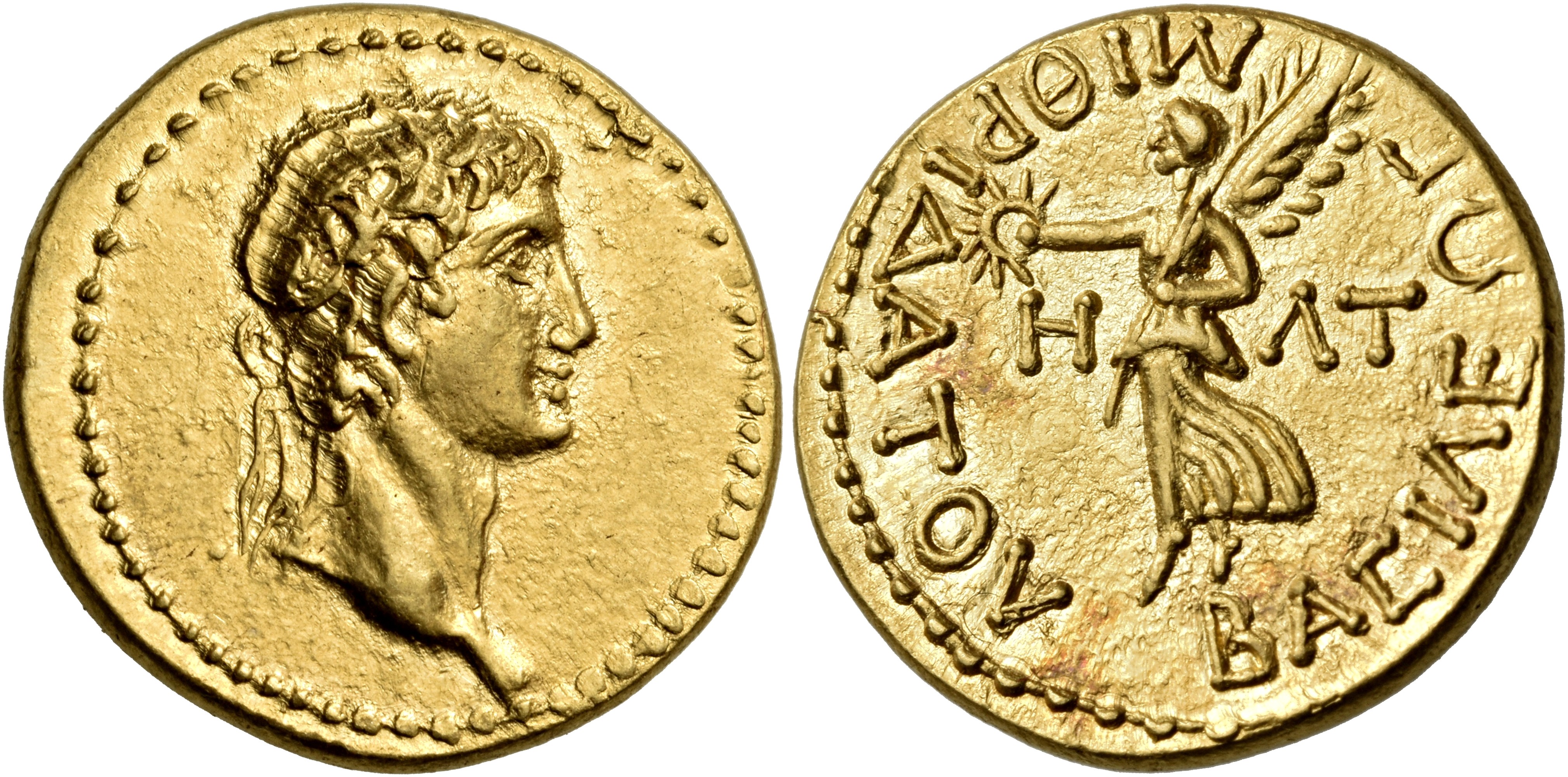
Fig. 1.2. Coin of Asander, King of Bosphorus depicting a Nike
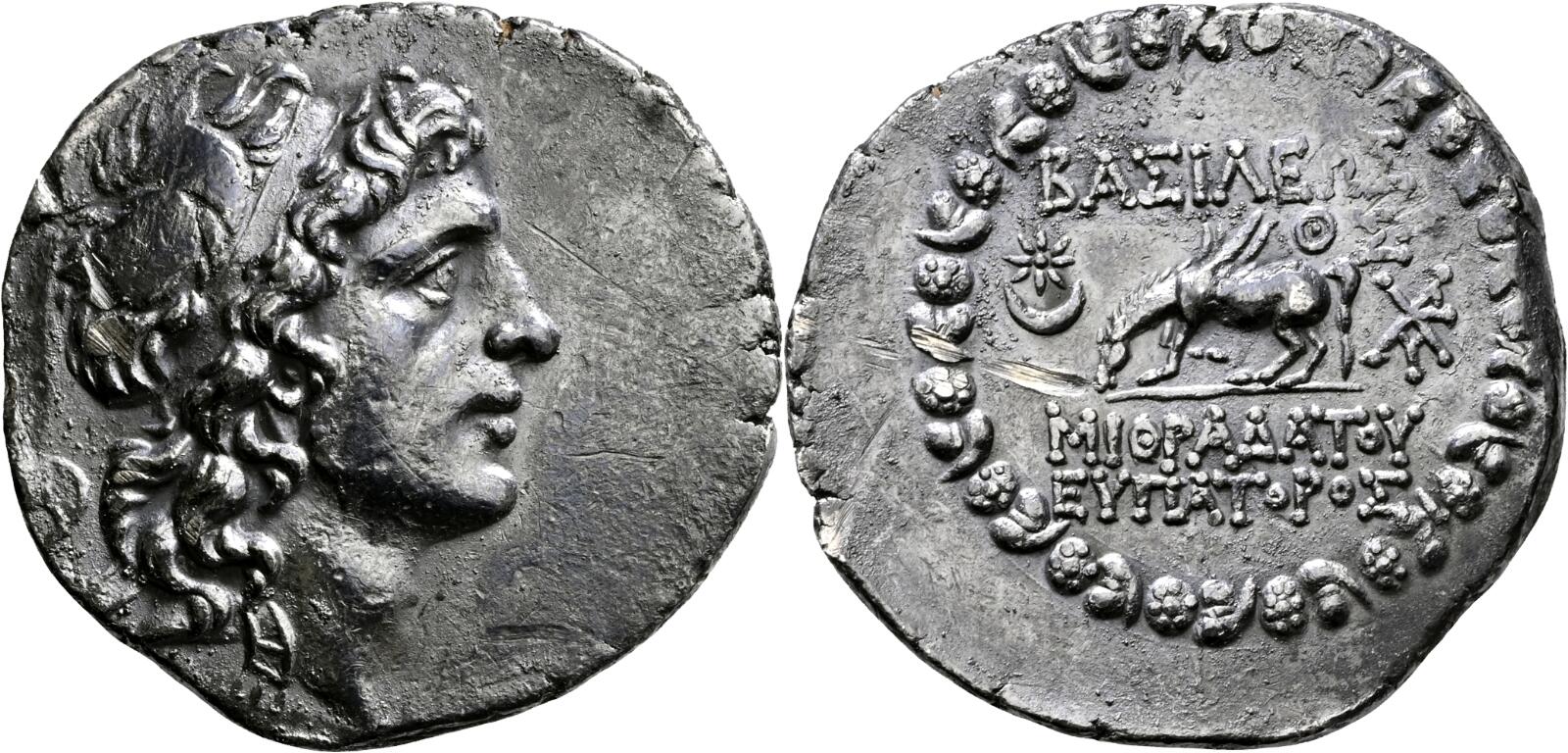
Fig. 1.3. Another depiction of Asander which shows the star and cresent that is visible in the Julius Caesar coin above. The coin also shows a winged Pegasus all within a Dionysiac wreath of ivy and fruit.
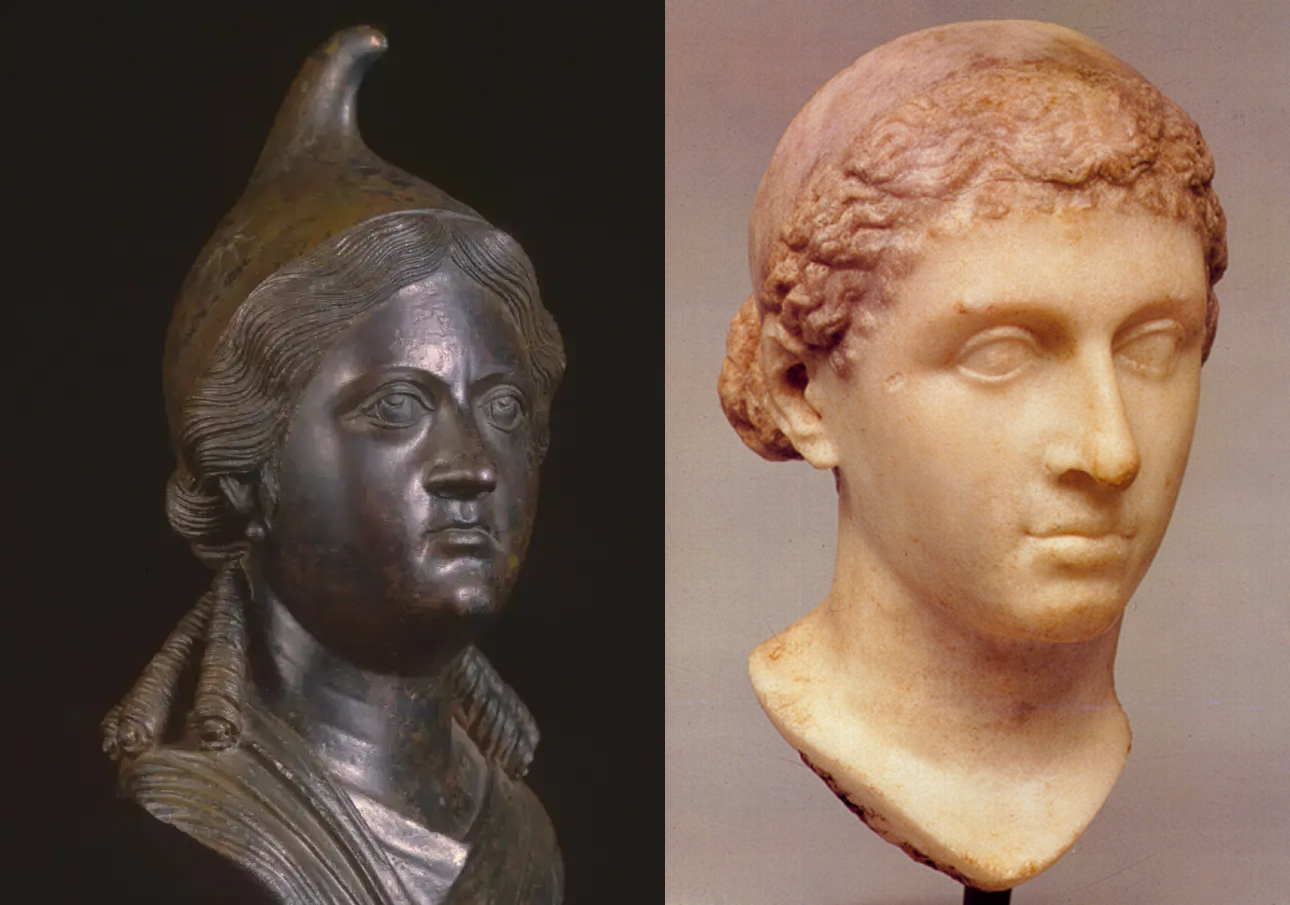
Fig. 1.4. (L) Dynamis, Queen of Bosphorus, (R) Cleopatra VII. There were obviously many years between the ages that she was depicted, however, even in the elder Dynamis bust you can see her lazy eye and abnormally large eyes which she was reported to have had, possibly as a consequence of inbreeding.

Fig. 1.5. (L) Julia Mamaea, Queen of Pontus (wife of Polemon II), (R) Cleopatra VII. Polemon Pythodoros, King of Pontus was Julius Caesar/Asander’s regional alias (Asander and Polemon were both married to Dynamis), and if he also played the religious role of Gaius Julius Sohaemus of Emesa, Priest-King of Emesa, and Cleopatra played the regional role of Pythodorida Philometor, then Julia Avita Mamaea of Emessa would have been their daughter. Do you see a resemblance? She would have been married to her half-brother (Cleopatra and Mark Antony’s son) Polemon II, King of Pontus aka Ptolemy Philadelphus aka Sampsiceramus I? The Bosphorus Kingdom, also known as the Kingdom of the Cimmerian Bosphorus, was located next to the Pontus Kingdom
Asander was born in 110 BCE, the same year as Julius Caesar. Dynamis was born in 70/69 BCE, the same year as Cleopatra VII. Julius Caesar was 30 years older than Cleopatra, and Asander was also 30 years older than Dynamis.
A statue from the Bosporan Kingdom, dated to Asander’s reign (ca. 47–17 BCE), refers to Asander as the ‘Great King of Kings Asandros Philoromaios Soter’ (Corpus Inscriptionum Regni Bosporani 30). So, he was a ‘King of Kings’, Soter (savior), and ‘The Great’. Individually, each of those titles carries significance, but the ‘Great King of Kings’ title in that inscription stands out because it is a rare title that was used by Cyrus the Great and Alexander the Great, so this shows Asander’s level of prestige and power to be placed alongside those two. Julius Caesar is the only historical figure who had a comparable level of prestige as Cyrus and Alexander.
Dynamis’s father was Mithridates VI Eupator who also carried the title “King of Kings”. Her uncle was Mithridates ‘Chrestus’ 5. Mithridates translates to ‘the gift of Mithra’ in ancient Persian and is an obvious reference to the Mithras cult.
Mithridates VI Eupator beat his brother Mithridates Chrestus in war to become king of Pontus/Bosphorus. In the mythology of ancient Rome, the city is founded as the result of a fratricide, with the twins Romulus and Remus quarreling over who has the favor of the gods and over each other’s plans to build Rome, with Romulus becoming Rome’s first king and namesake after killing his brother (this also mirrors the biblical account of Cain and Abel).
Mithridates VI, king of Pontus, was the father of both Pharnaces II and Dynamis (Cleopatra). Pharnaces II was born around the same time as Julius Caesar and Asander. So, if Asander was Pharnaces II then he was married to his sister.
Asander (Pharnaces II?) beat Mithridates Chrestus (his uncle) in battle to become King of Bosphorus. After Mithridates Chrestus’s loss to Asander he was imprisoned and executed by his elder brother, Mithridates VI Eupator, who had previously beat him in war.
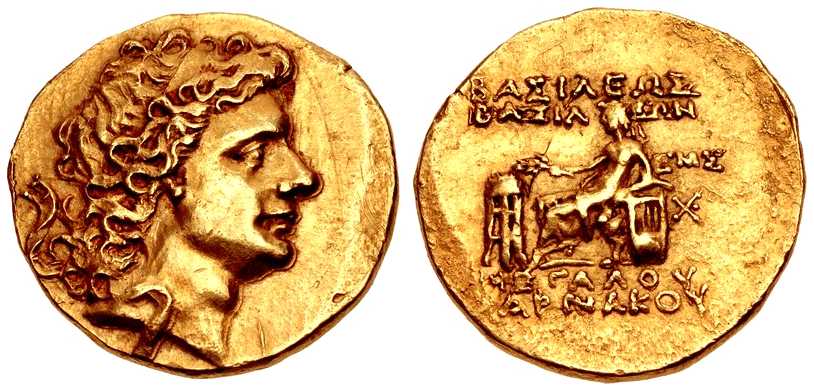
Fig. 1.6. Coin depicting Pharnaces II. Pharnaces II “dies” in 47 BCE right when Asander appears in 47 BCE as King of Bosphorus. Pharnaces II called himself “King of Kings” on coins (like Asander).

Fig. 1.7. Coin depicting Ariarathes IX Eusebes Philopator, King of Cappadocia. Notice the resemblence to Asander and Pharnaces II? They were all born on the same day as well.
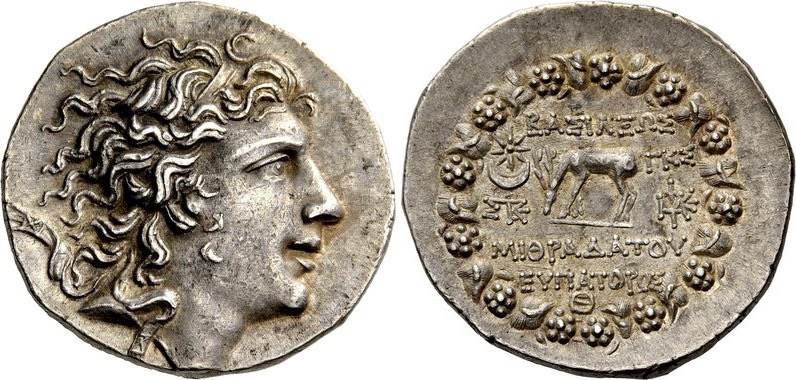
Fig. 1.8. Coin depicting Mithridates VI Eupator, father of Pharnaces II and Dynamis. Brother of Mithridates Chrestus. Notice the star and cresent that is visible in the Julius Caesar coin above and the winged Pegasus within a Dionysiac wreath of ivy and fruit that is seen in the Asander coin?
Julius Caesar aka Asander of Bosphorus aka Pharnaces II aka Ariarathes IX was also Brogitarix, king of Galatia. Brogitarix’s son Amyntas Nikator aka Amyntas of Galatia aka Jesus ben Fabus aka Isa Amen (Jesus Amen of Rev. iii. 14) 6 ruled an empire that stretched from modern-day Turkey through India.
Cleopatra aka Dynamis’s son with Julius Caesar aka Asander = Tiberius Julius Aspurgus Philoromaios, who was born about the same time as Caesarion (Aspurgus translates to “horseman-lord” in Thracian languages. Sabazios was a Thracian deity worshipped as a horseman. Cleopatra identified herself with the Greco-Egyptian godess Isis. So, he would have been Isa, son of Isis. The son of Isis in mythology was Horus, and that is why Caesarion’s iconography has a Horus falcon on it).
Cleopatra aka Dynamis’s son with Mark Antony 7 (aka Ptolemy of Cyprus, a brother of Ptolemy XII Auletes (Cleopatra’s father) making him Celopatra’s uncle aka Polemon I of Pontus aka King Herod aka Tiberius Claudius Nero aka Phraates IV of Parthia) = Alexander Helios aka Alexander (son of King Herod) aka Juba II who was married to his twin sister Cleopatra Selene II aka Queen Thea Muse Ourania. Juba II of Mauritania’s full name was Gaius Iulius Iuba, prenomen and nomen after his adopted father Gaius Iulius Caesar, and ‘Iuba’ is most likely a diminutive of ‘Iehuva’. He was the claimed royal heir of the Massylii tribe, which is the ‘Messiah’ lineage from David’s firstborn son with Saul’s daughter Michal (one way to prove that Mark Antony was also King Herod is through the equivalence of Alexander Helios aka Alexander (son of King Herod) aka Juba II).
Cleopatra aka Dynamis’s son with Mark Antony = Ptolemy Philadelphus who was Sampsiceramus I?
Mark Antony’s son with Livia Drusilla = emperor Tiberius Julius Caesar Augustus (one way to prove that Mark Antony was both King Herod and Tiberius Claudius Nero is through the equivalence of Doris the first wife of Herod the Great and Livia Drusilla the second wife of Octavius/Caesar Augustus (the Greek name Doris is a transliteration of the Roman Drus-us). Augustus was first married to Scribonia, but was divorced and he became engaged to Livia Drusilla (Doris), who was at the time pregnant, not by Augustus but by her own first husband Tiberius Claudius Nero, praetor of 41 BC and son of another Tiberius Claudius Nero, praetor of 62 BC).
Cleopatra aka Dynamis’s grandson with Mark Antony = Alexander (grandson of King Herod) aka Gaius Julius Alexander, Herodian Prince of Judaea aka Alexander Lysimachus aka Alexander the Alabarch aka Tiberius Julius Alexander Major aka (King/Tetrarch) Ptolemy (Alexander) bar Menneus aka Ptolemy of Mauretania (aka ‘Joseph Panthera’, the name for jesus’s father in the Talmud; Panthera is a corruption of Cantheras, or Cleopatros) aka Phraates V (the “King of Kings”) aka Monobazus I King of Adiabene, who was married to his sister Cleopatra (Thea Philopator) of Mauretania aka Cleopatra IX aka Pythodorida Philometor aka Helene aka Drusilla of Mauretania aka Julia Ourania of Parthia aka ‘Philo of Alexandria’ (aka Julius Philo, of the Julia gens, because she was the adopted granddaughter of Julius Caesar). She was also Claudius and Nero’s secretary Pallas and Vespasian’s first cousin and mistress Antonia Caenis. “The full name of Pallas was Marcus Antonius Pallas, the Antonius part is an obvious sign of descent from Mark Antony and that Pallas wasn’t a random slave. (Philo’s hebrew name was Yedidia which means “beloved of God”, or “friend of God”, which is the same as Theophilos in Greek. Around 26% of the New Testament was written to Theophilus in Luke and Acts of the Apostles).
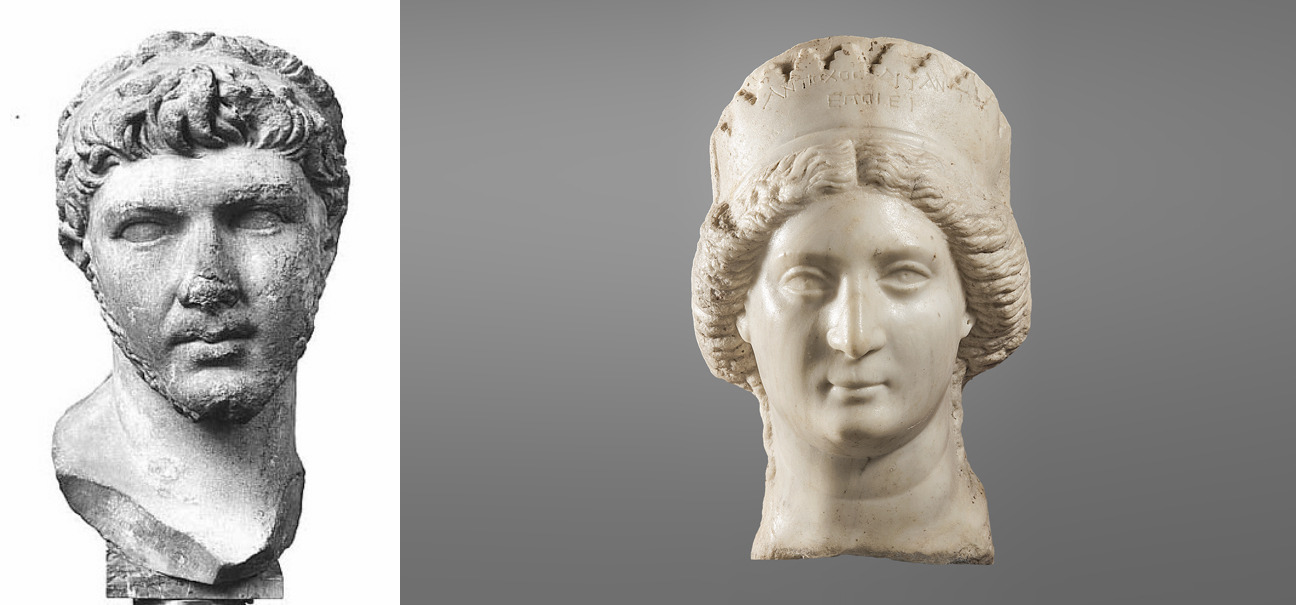
Fig. 1.9. (L) Alexander (grandson of King Herod) aka Gaius Julius Alexander, Herodian Prince of Judaea aka Alexander the Alabarch aka (King/Tetrarch) Ptolemy (Alexander) bar Menneus aka Ptolemy of Mauretania aka “Jesus” in the bible. (R) Cleopatra (Thea Philopator) of Mauretania aka Cleopatra IX aka Pythodorida Philometor aka Helene aka Drusilla of Mauretania aka Julia Ourania of Parthia aka Alexandra bat Mattathias aka ‘Philo of Alexandria’.
Alexander (grandson of King Herod) and his sister-wife Cleopatra (Thea Philopator) of Mauretania had two sons: Tiberius Julius Alexander aka Arrius Calpernius Piso aka Arrius Varus aka Tiberius Julius Cotys (In Thracian, ‘Cotys’ is related to the word ‘kotys’ which is a title that means ‘lord’) aka Emperor Nerva, and Marcus Julius Alexander aka Yeshua Cleopatros (Cantheras/Panthera) ben Josephus bar Menneus aka Ma’nu of Adiabene/Edessa aka Ptolemy aka Yakov Zu Tolomoy aka Izates aka Jesus Emmanuel aka Monobazus of Adiabene 8
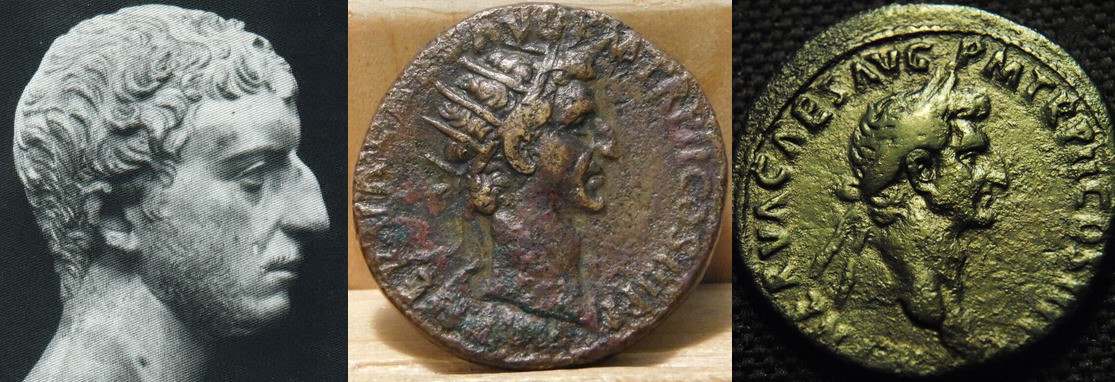
Fig. 1.10. ‘Josephus’ bust which I identify as Tiberius Julius Alexander. Compare it to Nerva’s depictions. So, ‘Josephus’ was Philo of Alexandria’s son. Tiberius Julius Alexander’s son was named ‘Philopappos’ and one of his mother’s aliases was ‘Alexandria bat Matthias’ which is where the pseudonym ‘Joseph bar Matthias’ comes from. Also, drop the initial b and final s in the name “Bar Mathias” and you get (Joseph of) Arimathea.
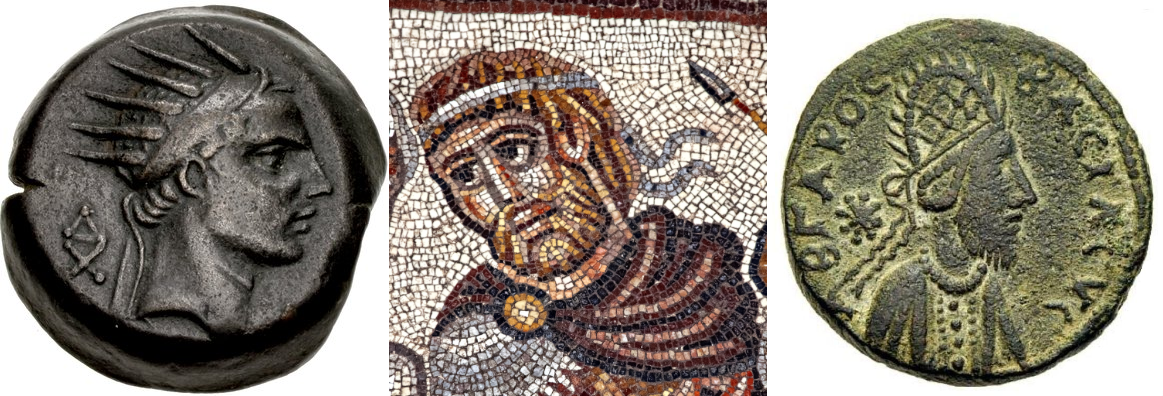
Fig. 1.11. (L) and (R) show King Izates Monobazus of Edessa (known in Greek as the “Kingdom of Ourania” or in English as the “Kingdom of Heaven”) wearing a crown of thorns. Izates or Izas is his title which is an ancient Greek translation of the Avestan word Yazatas (Persian: izad), meaning ‘lord’. He is one of the Jesus avatars, Isa in the Quran, and Sultan Ezid in the Yazadi (‘Iza’di) religion. He was the uncle of Tiberius Julius Sauromates II, King of Bosphorus. The middle image source: The Alexander Mosaic, Huqoq, Israel.
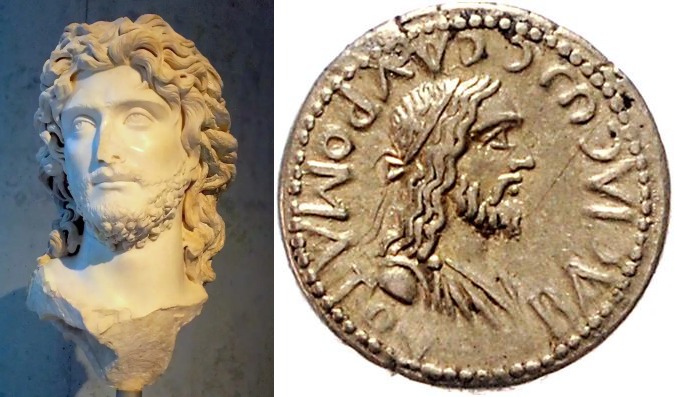
Fig. 1.12. Tiberius Julius Sauromates II, King of Bosphorus, who was the son of Tiberius Julius Cotys (aka Tiberius Julius Alexander aka Arrius Calpernius Piso aka Arrius Varus aka Emperor Nerva), great-grandson of Dynamis aka Cleopatra and Mark Antony. Does he look familiar? ΒΑCΙΛΕΩC CΑVΡΟΜΑΤΟΥ in the above coin translates to “King of the Sauromatians”. Sauromates is a Greek rendering of ‘Sarmatian’, referring to the Scythian tribe who came from the Pontic steppe. ‘Saur’ means ‘lizard’ or ‘reptile’, and ‘mates’ means ‘man’ or ‘warrior’. Therefore, translated literallly ΒΑCΙΛΕΩC CΑVΡΟΜΑΤΟΥ means “King of the lizard people”, or “king of the reptile people”. The Sarmatians were known for their use of scale armor, and this is where the reference comes from.
One name that shows up in the family trees of all the people listed above is Simon Boethus who I identify as (king/Tetrarch) Ptolemy (Alexander) bar Menneus aka Simon Magus. The name Boethus comes from Sabazios which is a translation of Zeus (Jupiter to the Romans) in the dialect and tradition of Phrygians and Thracians of Anatolia. Ma’nu is likely a diminutive of Menneus (‘son of man’) and then Manu-Sabazios becomes Monobazus which becomes ‘Bazus’ or ‘Bar Izates’ shortened to ‘baYZTus’ (or bar YZT) through frequent oral repetition which becomes ‘bOETHus’. He was likely also Simon the Essene the founder of the Essene sect and Simon Peter in the bible (the term ‘Peter’ is derived from the Latin ‘Pater’ meaning ‘father’, denoting the Essene High Priest. The Essenes called themselves ‘the Sons of Zadok’ and Simon was the heir of the Zadokite High Priest dynasty). His daughter Mariamne Boethus was the fifth wife of King Herod. He was the uncle of Jesus ben Fabus, great-great-great-grandfather of Jesus ben Gamla/Gamaliel aka King Izas Monobazus (the Talmud (Bereshit Rabbah 46:10) calls Izates and Monobazus the ‘Sons of Ptolemy’), and I identify Juba II as Alexander (son of King Herod) which makes him the grandson of Simon Boethus, and he was the great-great-grandfather of Vespasian.
Sabazius is related to the Saba/Sheba root meaning seven, rest, sated etc., and Jupiter-Sabazius is a Semitic or Semitized form of Jupiter, i.e. Turkish Judaism (the day of Sabbath was a festival of Sabazius (Plutarch (Symp. iv. 6)). Also, I(J)upiter was also called Jove or Iove to the Romans. The Latin pronunciation of Iove would have been Yoh-Way, i.e Yahweh/Yhwh, so Jove (Roman Zeus) Sabazios (Thracian Zeus) became conflated with Yahweh Saboath the god of the hebrew bible. Also, from Sabazios you get Zebedaios, sons of Zebedee.
Ptolemy Menneus/Simon Boethus’s son was named Philippion who I believe is a good candidate for Philip II Philoromaios and also Tiridates II of Parthia or Arsaces Philoromaios. Arsaces was the brother of Dynamis 9. So, Simon Boethus/Magus/Ptolemy (Alexander) bar Menneus, et.al., were the aliases of Ptolemy X Alexander I, king of Egypt, and Marriamme Boethus was another of Cleopatra’s regional aliases? If you identify King Herod as Mark Antony aka Tiberius Claudius Nero aka Phraates IV of Parthia’s regional alias then the picture becomes clearer.
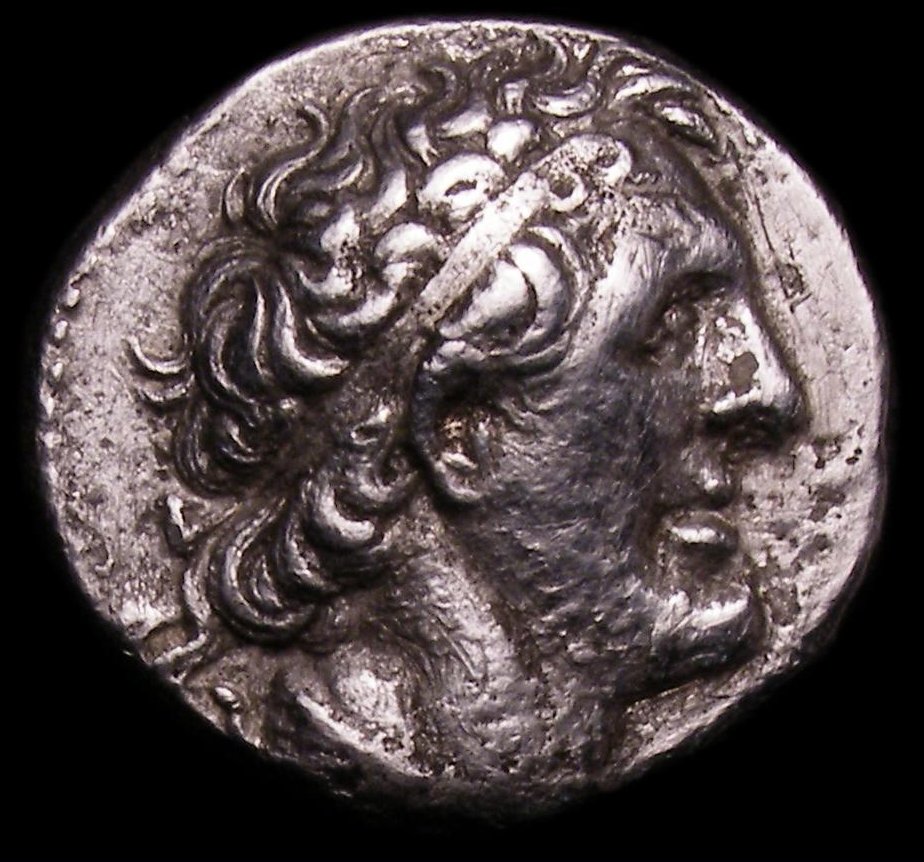
Fig. 1.13. Ptolemy XII Auletes/Ptolemy X Alexander I, king of Egypt, who was also Mithridates VI Eupator, Ariarathes VII of Cappadocia, Simon Boethus/Magus/Ptolemy (Alexander) bar Menneus, et.al. Mithridates VI married his sister Laodice—just as Ptolemy XII married his sister Cleopatra V. Both had daughters named Cleopatra who ruled (Cleopatra VII and Dynamis).
The connection between Simon Boethus/Magus/Ptolemy XII Auletes/Ptolemy X Alexander I/Ptolemy (Alexander) bar Menneus and Julius Caesar is obviously through his daughter Cleopatra whom Julius Caesar/Asander married. Using Josephus as a source, Antipater the Idumean’s son King Herod was married to Simon Boethus’s daughter Mariamme and Antipater the Idumean saved Julius Caesar’s life during the Battle of the Nile (47 BC). As a reward, Josephus claims that Julius Caesar adopted King Herod’s sons (Simon Boethus’s grandsons) Aristobulus IV (Vespasian’s grandfather 10, Alexander (son of king Herod) aka Alexandros III aka Juba II, Herod Antipas the Tetrarch, Archelaus, and Philip and raised them in Rome, in the household of Gaius Asinius Pollio which was the same household that Caesar Augustus was raised in (Josephus, “Antiquities of the Jews”, Book 15, Chapter 2. Josephus, “Antiquities of the Jews”, Book 17). This is untrue and those kids were his biological sons. It is also untrue that Alexander, son of King Herod, was killed by his father Herod, Josephus even has a story about a ‘spurious Alexander’ that showed up in Rome claiming to be the son of Herod who faked his death 11, so he was ‘resurrected’ as Juba II, king of Numidia and Mauretania.
Endnotes (Chapter 3)
(a) Amyntas Nikator aka Amyntas of Galatia aka Jesus ben Fabus aka Isa Amen (Jesus Amen of Rev. iii. 14) is an interesting figure. Historian Ranajit Pal has made the claim that Alexander the Great = Chandragupta Maurya (Alakshandra is a Sanskritized translation of Alexander and Gupta means guardian or protector in Sanskrit, the exact meaning of Alexander) who was an Indian emperor who founded the Mauryan Empire, one of the largest and most powerful empires in ancient India. (See: “Alexander and Chandragupta in Sanskrit Drama” by Ranajit Pal https://www.academia.edu/40074507/ALEXANDER_AND_CHANDRAGUPTA_IN_A_SANSKRIT_DRAMA [link]). He also claims that Diodotus I Soter (Alexander’s successor to eastern territories) = Ashoka the Great (Chandragupta’s successor). (See: “Diodotus I was Ashoka” by Ranajit Pal https://www.academia.edu/695219/Diodotus_I_was_Ashoka_An_Altar_of_Alexander_Now_Standing_Near_Delhi [link]). This would mean that Alexander completed his conquest of India and then adopted a local identity. So, India was under Greek rule since Alexander. Being the king of a region populated by Gauls, Amyntas of Galatia’s religion would have been Druidism. The ancient Vedas are just the eastern branch of Druidism (https://www.academia.edu/13113385/Druidism_and_Vedism_Compared). The name Abaris or Abharas, from Abaris the Hyperborian, the Druid teacher of Pythagoras, derives from the Old Irish word abhar, which means chief or noble and was a generic term for Druid or Chief Druid. Abharas is also related to the Sanskrit word Bhārata, a legendary king in the Vedas. Bhārata is at the root of the word Bharatvarsha which is a term that is used to refer to the Indian subcontinent as a whole.
(b) Suetonius (Divus Julius 88) notes Caesar’s comet or ‘Julian Star’ (or Sidus Iulium) rose during his funeral games, interpreted as his soul’s ascent—eerily similar to Christ’s resurrection narrative.
(c) Apollonius of Tyre was married to the daughter of a king of Libya (“Historia Apollonii Regis Tyri” or “The Story of Apollonius, King of Tyre”), who was Cleopatra Selene aka Drusilla (aka Cleopatra (Thea Philopator) of Mauretania aka Cleopatra IX aka Helene aka Julia Ourania of Parthia aka Philo of Alexandria. Drusilla was the wife of Azizus who was her brother Juba II (Alexander Helios aka Alexander (son of King Herod)) aka Gaius Julius Alexander, Herodian Prince of Judaea aka Alexander Lysimachus aka Alexander the Alabarch aka Tiberius Julius Alexander Major aka (King/Tetrarch) Ptolemy (Alexander) bar Menneus aka Ptolemy of Mauretania aka Phraates V (the “King of Kings”) aka Monobazus I King of Adiabene).
https://en.wikipedia.org/wiki/Apollonius_of_Tyre_(philosopher)
https://en.wikipedia.org/wiki/Apollonius_of_Tyre
So, Alexander aka Juba II was also Apollonius of Tyre. Juba II carried the title “Rex Literatissimus” which can be translated as “Most Learned King” or “The Most Scholarly King”. He was known as a philosopher. Is Apollonius of Tyre the same person as Apollonius of Tyana? This would make Apollonius of Tyana the brother-husband of Philo of Alexandria and the father of Josephus. These three created the core of Christianity.
(d) Gautama Buddha was Gaumata Bardya, the son of Cyrus the Great. Ptolemy I Soter and his successors were closely associated with Serapis. “Jesus” was an avatar for the Bosphioran royal family. Apollonius of Tyana was king Juba II, the grandson of Julius Caesar/Asander and Cleopatra/Dynamis. All these aristocrats/kings took on religious personas and preached syncretic versions of Greco-Buddhism to the public: monotheism, renounce worldy possessions, asceticism, shame and guilt, you will be rewarded in the afterlife for your earthly suffering, etc. These cults were by design slave moralities to strip the will to power from the population to prevent rebellions.
My research on the origins of Christianity takes me to the Bosphorus river in classical Anatolia (Julius Caesar = Asander, King of Bosphorus, and Cleopatra = Dynamis). This is incongruent with mainstream history. However, there are a few revisionist authors such as Anatoly Fomenko and Gunnar Heinsohn who make the claim that the Western Roman Empire is a duplicate of the Eastern Roman Empire not the other way around and that much of the history of the Western Roman Empire was conjured up by the Church Fathers, Jesuits, Joseph Justus Scaliger, and medieval forgers, either to retrofit history to align with the Bible, due to conflicts between the Vatican and the Eastern Byzantine Church, or for profit.
The area of modern-day Istanbul was once called ‘Basileía tôn Rhômaíôn’ (‘Kingdom of the Romans’) and the people of that region called themselves Rhōmaîoi (Romans). Historians assume that region got it’s name after Roman colonization, but why? Every romance language based on Latin underwent a linguistic evolution except Romanian, which is the closest language to classical Latin. Could it be that the original Romans hailed from Romania and then moved south to Anatolia? A substantial part of Byzantine coinage from two millennia ago boasts inscriptions in Latin and not in Greek, including the Asander of Bosphorus coin in Fig. 1.1.
There is genetic and historical evidence proving the Rome on the Bosphorus theory. Rome was founded by Italic tribes of “Indo-Europeans”. However, this is where academic definitions fail because those founders of Rome were actually 85%+ Anatolian Early European Farmer (EAF). The Etruscans who established Rome were invaders from Anatolia, and the Carians who hailed from southwest Anatolia have a strong connection with the settlement of Rome (Aquilla = Qos = god of Kos of Caria).
Endnotes (Chapter 4)
(a) Asander and Dynamis had one known son, Tiberius Julius Aspurgus Philoromaios. He was born about the same time as “Caesarion” and “Emperor Tiberius Julius Caesar”. His wife, known only through numismatic evidence, was Gepae-pyris. Tiberius and Gepaepyris had two sons; the eldest was “Tiberius Julius Mithridates Philo-Germanicus Philopatris” (“son of Mithra, lover of Germanicus, lover of father”). Their second son was “Tiberius Julius Cotys I Philocaesar Philoromaios Eusebes” (“lover of Caesar, lover of Rome who is the Pious One”).
Tiberius Julius Aspurgus Philoromaios (son). Married to: Gepae-pyris. Children:
Tiberius Julius Mithridates Philo-Germanicus Philopatris (eldest son)
Tiberius Julius Cotys I Philocaesar Philoromaios Eusebes (second son)
Now, let’s connect this family to the Roman Emperor’s family:
Emperor Tiberius Julius Caesar
Adopted son and heir: Germanicus
Biological son: Drusus
Tiberius Julius Aspurgus Philoromaios and Emperor Tiberius Julius Caesar were born around the same time, and their sons were also born around the same time.
Also, Polemon Pythodoros (Julius Caesar/Asander) and Pythodorida of Pontus (Cleopatra/Dynamis) had a daughter Antonia Tryphaena. Her son was Rhoemetalces II whose reign coincided with emperor Claudius.
Emperor Titus = Polemon II of Pontus who was the prince of the Bosporan, Pontus, Cilicia, and Cappadocia.
I asked ChatGPT to translate Roman emperor names and Bosphorian princes and kings names into Celtic (the Galatians were Gauls), Latin, and Etruscan and try to find the Roman emperor identities among the Bosphoran elite. This is the result:
-Augustus: The Celtic name “Ogur” or “Augus” could be transliterated to the Etruscan name “Avile” or “Aule”, which means “great” or “magnificent”. The Etruscan name “Avile” is similar to the Latin name “Augustus”. Aspourgos, a king of the Bosphorus, has a similar name meaning, with the Greek name “Aspourgos” being similar to the Etruscan name “Avile”. The Phoenician name “Asgar” or “Asgaros” could also be related, meaning “great leader” or “king”. The Celtic name “Augus” could also mean “lord” or “master”, similar to the Etruscan name “Avile”.
-Tiberius: Tiberius means “of the Tiber” in Latin. The Bosphorus has a river called the Thibaris, which might be connected to the name Tiberius. A possible match is Tiberius Julius Aspurgus, a king of the Bosphorus, who ruled from 8 BC to 38 AD. His birth date is unknown, but his reign overlaps with Tiberius’ (14 - 37 AD). The Celtic word “tibor” means “lord” or “master”, which could be related to the name Tiberius. The Bosphorian king Tiberius Julius Aspurgus has a name that combines Latin and Celtic elements. The Celtic name “Tigernach” means “lord” or “master”, which could be transliterated to “Tiberius”. The Thracian name “Tiberios” or “Tiberos” could also be related, meaning “lord” or “master”.
-Caligula: The Celtic name “Caulgach” could be transliterated to the Etruscan name “Kalikle” or “Kalike”, which means “warrior” or “soldier”. The Etruscan name “Kalikle” is similar to the Latin name “Caligula”. Cotys I, a king of the Bosphorus, has a name that means “warrior” or “soldier” in Greek, with the Celtic name “Cotys” being similar to the Etruscan name “Kalikle”. The Illyrian name “Kalikos” or “Kalikus” could also be related, meaning “strong” or “powerful”.
-Claudius: The Celtic name “Cladach” could be transliterated to the Etruscan name “Klute” or “Kluti”, which means “shore” or “beach”. The Etruscan name “Klute” is similar to the Latin name “Claudius”. Mithridates III, a king of the Bosphorus, has a name that means “great warrior” in Greek, with the Celtic name “Mithrid” being similar to the Etruscan name “Klute”. The Scythian name “Klutos” or “Klutus” could also be related, meaning “glorious” or “famous”. Lord is found in the Celtic translation of “Cladach” as “lord of the shore”.
-Nero: The Celtic name “Nerach” could be transliterated to the Etruscan name “Nerke” or “Nerki”, which means “strong” or “powerful”. The Etruscan name “Nerke” is similar to the Latin name “Nero”. Tiberius Julius Cotys II, a king of the Bosphorus, has a name that combines Latin and Celtic elements, with the Greek name “Cotys” being similar to the Etruscan name “Nerke”. The Germanic name “Nerikos” or “Nerikus” could also be related, meaning “strong” or “powerful”.
-Vespasian: The Celtic name “Vespag” could be transliterated to the Etruscan name “Vespe” or “Vespi”, which means “wasp” or “stinging insect”. The Etruscan name “Vespe” is similar to the Latin name “Vespasian”. Rhescuporis, a king of the Bosphorus, has a name that means “he who is stung” in Greek, with the Celtic name “Rhescu” being similar to the Etruscan name “Vespe”. The Phoenician name “Vespas” or “Vespasos” could also be related, meaning “wasp” or “stinging insect”. Lord is found in the Celtic translation of “Vespag” as “lord of the wasps”.
-Domitian: The Celtic name “Domnach” could be transliterated to the Etruscan name “Dumne” or “Dumni”, which means “lord” or “master”. The Etruscan name “Dumne” is similar to the Latin name “Domitian”. Sauromates I, a king of the Bosphorus, has a name that means “ruler of the land” or “lord of the earth” in Greek, with the Celtic name “Domnach” being similar to the Etruscan name “Dumne”. The Thracian name “Dom
Vespassian was also a great-grandson of Cleopatra and Mark Antony (King Herod). He was Herod Pollio aka Herod Agrippa I, grandson of King Herod’s son Aristobulus IV. Vespasian was his title, not his name (Vas/Bas was the royal abbreviation for the Greek word Basilius which = King, and Pasius = Peace. ‘Vespasian’ = ‘King Peace’) 12. He was also ‘Flavius Scaevinus’ the conspirator who was involved in Nero’s assassination.
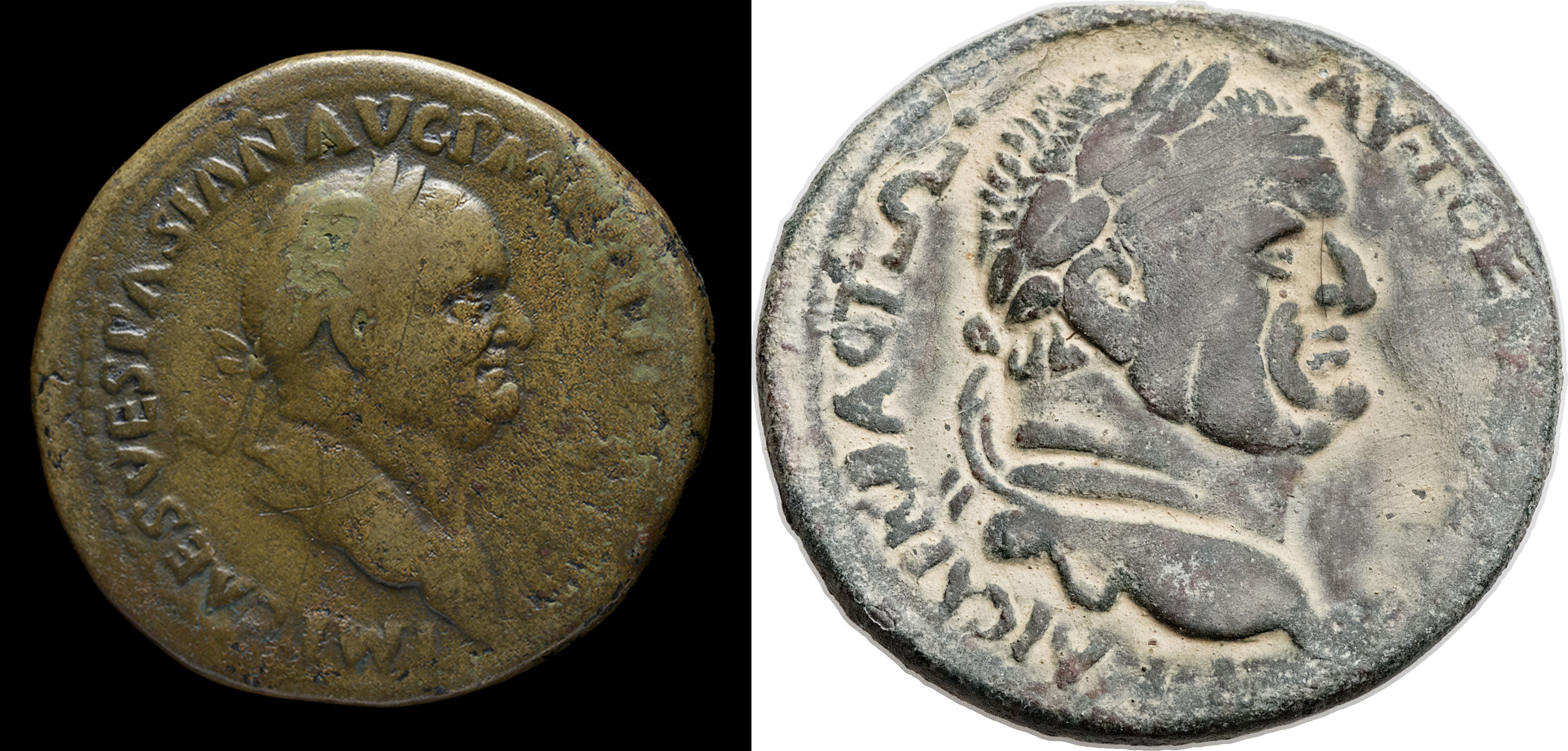
Fig. 1.14. Compare Vespasian’s depiction to Herod Agrippa I
‘Antonia Caenis’ was Vespassian’s mistress who was his first cousin who was Cleopatra (Thea Philopator) of Mauretania aka Cleopatra IX aka Helene aka Drusilla of Mauretania aka Julia Ourania of Parthia aka Philo of Alexandria. (Caenis was the Greek goddess who was transformed into a man, and she role-played as two men: Marcus Antonius Pallas and Philo).
Cleopatra (Thea Philopator) of Mauretania aka Cleopatra IX aka Helene aka Drusilla of Mauretania aka Julia Ourania of Parthia aka Philo of Alexandria aka Antonia Caenis’s son was Tiberius Julius Alexander aka Josephus who was the Prefect (leader) of the Praetorian Guard which made him arguably the most powerful man in the empire during Vespasian’s reign.
Vespasian’s son Titus was in a relationship with his aunt Berenice, granddaughter of King Herod, who was St. Veronica in the bible (Veronica is a transliteration of the Greek name Berenike meaning ‘victory’).
Berenice’s brother Marcus Julius Agrippa II, whom she was in an incestuous relationship with before moving on to her nephew (previous to this she was married to her uncle Herod of Chalcis), was the governor of all foreign Roman territories except Egypt (which was governed by Tiberius Julius Alexander) during the Flavian period.
Emperor Vitellius was probably an alias for Vespasian’s older brother Titus Flavius Sabinus who was married to Mariamne III aka “Arria the Elder” (“Arria” from her father’s name judean king Aristobulus IV who was the son of King Herod and he was also Julius Caesar’s adopted son. Aristobulus IV was likely Vespasian and Vitellius’s father, so like his cousin Alexander (grandson of King Herod), he was also married to his sister).
Endnotes (Chapter 5)
(a) Theory: Alexander (grandson of King Herod) aka Gaius Julius Alexander, Herodian Prince of Judaea aka Alexander Lysimachus aka Alexander the Alabarch aka Tiberius Julius Alexander Major aka (King/Tetrarch) Ptolemy (Alexander) bar Menneus aka Ptolemy of Mauretania was also the Roman general ‘Gnaeus Domitius Corbulo’. Gnaeus Domitius Corbulo conquered Armenia alongside Tiberius Julius Alexander (his son Tiberius Julius Alexander aka Arrius Calpernius Piso aka Arrius Varus aka Tiberius Julius Cotys aka Emperor Nerva), after which, Tigranes VI (Tiberius Julius Alexander) was installed as king. Compare his bust [link] to the famous ‘Josephus’ (Tiberius Julius Alexander) bust [link]. Notice a resemblance? If this is correct, then he (Alexander) would have been the brother-in-law to Caligula and father-in-law to Domitian. Tiridates of Armenia (who would have been Mithridates Chrestus’ great-great-grandson) was the one who spread the religion Mithraism which was a syncretic a slave-morality religion to subjugate the Parthians. Mithras is inspired by Zoroastrianism, the religion of the Persians/Parthians, but Mithras is the same as Sabazios. It’s a solar son deity, a Jupiter.
Identifying Julius Caesar as Asander of Bosphorus necessitates a re-examination of his name.
Galata in Classical Anatolia was settled by the Gauls. Galatia bordered the Bosphorus, and Julius Caesar/Asander was king of this region. The king of Galatia during this time was Asander’s brother-in-law Amyntas of Galatia who ruled an area that stretched into India under the alias Amyntas Nikator.
“Gaius” then can refer to Asander’s connection to the Gallian (Gauls (Galli = Celt in Latin)) people or his ancestry in the region.
Ceasar’s gentilice (surname) was Iulius. Iulius can refer to the ancient Celtic tribe known as the Iudii or Iudaei. “Ioulios” (ιούλιος) in Greek also means “descended from Jupiter” or “son of Jupiter”. So, it is possible that the word “jew” comes from the Iudii or Iudaei.
Caesarus referred to a Celtic chieftain. For example, Caesorix was the leader of the Cimbri tribe during the Cimbrian War.
Gaius Julius Caesar was a title, and Gaius Julius Caesar could conceivably translate to: Chieftain of the Iudii or Iudaiei tribe from Galatia.
I(J)upiter was called Jove or Iove to the Romans. The Latin pronunciation of Iove would have been Yoh-Way, i.e., Yahweh/Yhwh, so Yahweh Saboath, the god of the hebrew bible, is I(J)ove (Roman Zeus) Sabazios (Thracian Zeus).
‘Ashkenazi’, or ‘Ashkuza’, was the name given to the Scythians by the ancient Akkadians (Josephus. Vol. 5: Antiquities: 8:2:5, pp. 593-595). The Assyrians called the Scythians “Asguzaya” and the ancient Persians called the Scythians ‘Saka’. In Biblical Hebrew, the Ashkuz (Ashkenaz) are considered to be a direct offshoot from the Gimirri, known as the Cimmerians to the ancient Greeks. Cimmerians were a Middle Eastern offshoot of the Celtic Cimbri tribe. The Bosphorus Kingdom that Asander ruled over was also known as the Kingdom of the Cimmerian Bosphorus.
As for the term ‘Hebrew”, it comes from the Celts as well, who called themselves Iberi. The name of Abaris the Hyperborean, a Druid priest who was Pythagoras’s teacher shows this. Iber was sometimes rendered as Aber or Heber and is pronounced as Hebrew in the Hebrew languages. Hyperborea, which just like Atlantis, was another name for Ireland. The word Atlantis means ‘The Island of Atlas’. The titan Atlas was a key figure in Greek mythology and is depicted as being the bearer of the heavens. According to early Greek mythology, Atlas lived on the island of Hyperborea. Over time Hyperborea became Hybernia or Hibernia, the Roman name for Ireland. Iber is an ethnonym that shows up in areas where the Celtic people settled (Ebro river, Iberia, Hibernia, etc.).
Abel and Cain are just a copy of Romulus and Remus. Judas Iscariot is a copy of Brutus. Genesis 4:5-31. Enoch, Irad, Mehujael, Methuselah, Lamech, Seth, Enosh, Kenan, Mahalalel, are copies of Titus Livy’s Regal Rome of the seven kings.
Also, Caesar, Kaiser (German for Caesar), Kesar or Kaysar (Persian for Caesar), Kaisar (Ancient Greek for Caesar), Tsar (Russian for Caesar) and Khazar are not just phonetic coincidences. It all ties back to the Divine Julius cult.
So, it seems that the Romans (in Anatolia) tried to assimilate the tribe that became modern jews by forcing their imperial cult on them and they got their identity from here. This is why several prominent members of this royal family identified as “Jews” despite being Aryan Sarmatians and Celtic Galatians.
The Celts in classical Galatia worshiped a deity called Hesus/Esus/Iesus. The Celtic name Esus is believed to be related to the Proto-Celtic word “aisu”, which means “lord” or “master”. The letter “J” was invented in the 17th century, so the name “Jesus” would have been “Esus” in the classical sense.
In the name Asander, “Asa” means “lord” in Thracian, and “andros” means “man” or “son of man” in Greek. Jesus is refered to as “the son of man” 81 times in the four canonical gospels. Asandros can also be interpreted as “son of the lord” or “son of Asa, the lord”. The Etruscan word “Aesar” (also spelled “Aeser” or “Aisar”) where Asa could also derive from means “god” or “divine”. So, Asandros can translate to either “son of god”, or “son of Lord Esus”.
Hesus/Esus/Iesus then eventually phonetically shifted to I-zas/Izas/Izates.
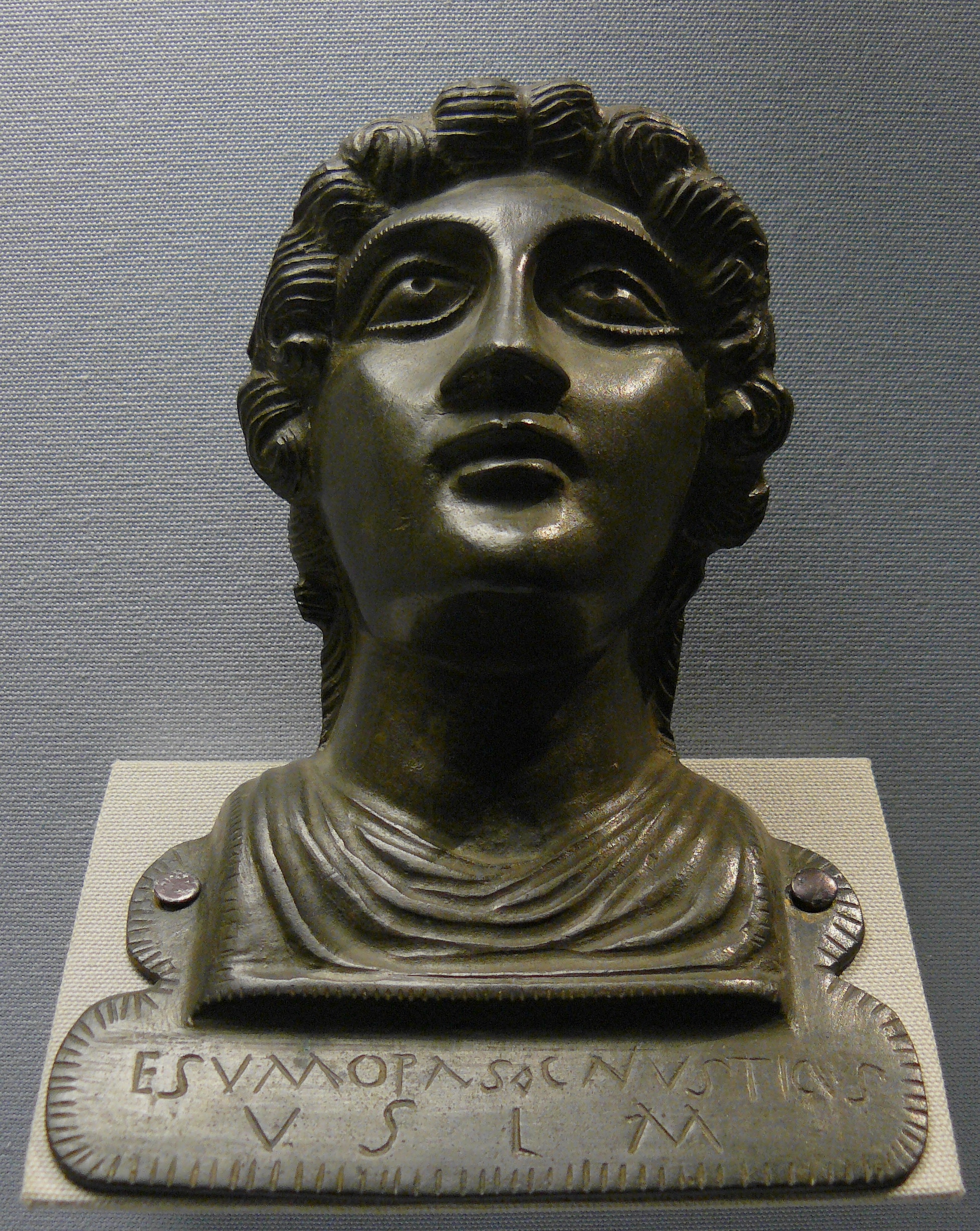
Fig. 1.15. Statue from classical Anatolia that is dedicated to “Esumopas Cnusticus”. Esumopas means “Slave to Esus”, and Esus means lord in Proto-Celtic. If you combine the Etruscan word “cnus” with the suffix “-ticus” or “-tic-“ you get a word that translates to “anointed one” or “consecrated one”, ie. a “Christ”. So, that inscription translates to: “Slave to Lord (Esus) Christ”. The “VSLM” inscription is an abbreviation for the Latin phrase “Votum Solvit Libens Merito” which translates to “He pays his vow willingly and with merit” or “He fulfills his vow with pleasure and deserving”, which is often found on Roman coins and other artifacts. Esus was crucified in mythology and his symbol was an axe, so he was associated with woodcutting, forestry, carpentry.
Endnotes (chapter 7)
(a) In many languages the word “As” is found as the designation of the supreme deities. In Norse mythology, the Aesir (or Asas) refer to the principal gods, including Odin, Thor, and Freyja. In ancient Persian mythology, “As” is associated with Mithras, but also with other deities such as Ahura Mazda, who was the supreme god of the Zoroastrians. In Egyptian mythology, the god Ash or As is a minor deity associated with the sun and the pharaohs. In Greek mythology, the Titan Atlas is sometimes referred to as “As” or “Aas,” which may be related to the ancient Greek word “axios,” meaning “worthy” or “divine.”. “Asa” means “lord” in Thracian. In Hindu mythology, the Asuras are a class of powerful beings who are often depicted as gods or demigods. In Slavic mythology, the god Perun is sometimes referred to as “As” or “Asa,” which may be related to the ancient Slavic word “asen,” meaning “noble” or “divine.”. The Etruscan word “Aesar” (also spelled “Aeser” or “Aisar”) means “god” or “divine”. As is at the root of Caesar.
(b) This is why all christian celebrations derive from Druidism. Druidic Calendar: Yule (Winter Solstice) - December 21/22 Celebrate the rebirth of the sun (Christian Equivalent: Christmas (December 25)). Imbolc - February 1/2 Mark the midpoint between Yule and the spring equinox (Christian Equivalent: Candlemas (February 2)). Ostara (Spring Equinox) - March 20/21 Welcome the return of spring with eggs, rabbits, and feasting (Cristian Equivalent: Easter (movable date, typically in March or April)). Beltane - May 1/2 Honor the spirits of the land and the cycles of nature (Christian Equivalent: May Day (May 1) or Ascension Day (movable date, typically in May)). Litha (Summer Solstice) - June 20/21 Celebrate the peak of the sun’s power (Christian Equivalent: St. John’s Day (June 24)). Lammas - July 31/August 1 Mark the beginning of harvest time (Christian Equivalent: Feast of the Transfiguration (August 6) or Lammas Sunday (movable date, typically in August)). Mabon (Autumn Equinox) - September 20/21 Celebrate the second harvest (Christian Equivalent: Michaelmas (September 29) or Harvest Festival (movable date, typically in September or October)). Samhain - October 31/November 1 Honor the ancestors (Christian Equivalent: All Saints’ Eve (October 31) or All Souls’ Day (November 2)).\
Sometime after the Bar Kokhba Revolt (132–136 CE), a group of rabbis that were headed by a rabbi named Akiva who led the Talmudic Pharisees and is responsible for large parts of the Talmud, Sefer Yetzirah (book of creation), the Mishna and the Midrash Halakha, and modern judaism, and who was a student of Gamaliel (Paul the Apostle claimed that he was brought up in Jerusalem “at the feet of Gamaliel” (Acts 22:3)), and who was the one that came up with the idea that “Rome was Edom”, realized that subversion was the only way to defeat the Romans. So, rabbi Akiva and his students Aquila of Sinope aka Onkelos, Markianos of Alexandria aka Marcion (Greek Markion) of Sinope, Shimon bar Yohai aka Simon Peter (Shimon bar Yonah) (Simon’s mythology was stolen from the Roman deity Janus who was the keeper of keys/gatekeeper role. Eusebius reported that Philo had met Simon Peter in Rome), Ketia bar Shalom aka ‘Clement of Rome’ (hebrew Ketia is the same as Latin Clement), Aristo of Pella who is a good candidate for being Luke the Evangelist (‘Aristo’, or ‘Ariston’ is a name that is related to ‘Proteus’ The former means ‘first-rank, noble’ the second derives from ‘first’. So, was he also Peregrinus Proteus? Also, Mark or Mahalia, sixteenth bishop of Jerusalem was the secretary of Aristo and Marcion is known to have had a disciple named Lucanus as documented by Tertullian, so Mark, or Mahalia, first Gentile bishop of Jerusalem was also Markianos of Alexandria aka Marcion of Sinope?), Rabbi Yehuda aka Jude the Apostle (Yehuda is the Hebrew equivalent of Greek Jude), and Rabbi Meir aka Polycarp aka Bishop ignatius (the name “Meir” means “one who illuminates”. Ignatius means firey one and Polycarp was famous for lighting himself on fire), added a slave-morality suicide cult to the imperial cult.
Many of rabbi Akiva’s students and contemporaries had connections to the Alexandrian School in Egypt and were themselves students of Philo of Alexandria.
Rabbi Akiva was likely Paul the Apostle. In Acts 22:3 “Paul” claims to have been educated at the feet of Gamaliel who was the teacher of rabbi Akiva, and in Acts 18:2-3 and Romans 16:3 NASB, it is claimed that Aquila of Sinope and his wife Prisca or Priscilla lived with Paul the Apostle and Paul called them “my fellow workers in Christ Jesus. Paul’s/Saul’s fictional life story was stolen from the ancient Egyptian story “Tale of the Shipwrecked Sailor”.
Quintus Tinnius Rufus (Turnus Rufus the Evil) was Pontius Pilate, the Roman governor of Judaea who crucified Simon bar Kokhba and killed rabbi Akiva. Rabbi Akiva preached that Simon bar Kokhba was the jewish messiah.
Esus then became Esau (Edom) the progenitor of the Edomites in the bible, a metaphor for the forces of oppression and injustice. The Jewish version of Antichrist (Armilus) is based on Romulus (Armilus is a Hebrew corruption or adaptation of the Latin name Romulus). The Greco-Egyptian deity Serapis (the horned deity) became Satan (Pan (Greek) or Cernunnos (Celtic) were also horned Pagan deities). Lucifer, or “lucem ferre”, which means “light-bearer” or “morning star”, is Venus who was the Roman goddess whose functions encompassed love, beauty, desire, sex, fertility, prosperity, and victory. In Roman mythology, she was the ancestor of the Roman people through her son, Aeneas. In Norse mythology Iðunn/Idun (equivalent to Greek Hebe, and Celtic Brigid), is the goddess of youth, her name means “giver of eternal youth”. The other gods get golden apples from her. She stores them in a basket and they keep the gods young until the end of the world. Idun became Eve in the bible the archetypal sinner whose actions brought death into the world (Romans 5:12). Inanna (equivalent to Freyja (Norse mythology), Aphrodite (Greek mythology), Venus (Roman mythology), and Morrigan (Celtic mythology)), the ancient goddess of war, love, and fertility, became the Whore of Babylon. Artemis, the goddess of the wilderness, wild animals, nature, vegetation, childbirth, care of children, and chastity, became recast as a witch (19:24). (The demonization of Venus (lucifer), Idun/Hebe/Brigid, Inanna/Freyja/Aphrodite/Venus, Artemis, and other female Pagan deities, was designed to instil a strong hatred of women among European men). Also, the jews’ hated enemy in the bible are the Celts (Gog or Goy). Flavius Josephus in the ‘Antiquities of the Jews’. Book I. Chapter 1: “For Gomer founded those whom the Greeks now call Galatians [Galls], but were then called Gomerites. Magog founded those that from him were named Magogites; but who are by the Greeks called Scythians”. Josephus is suggesting that the Hebrew word “Goy” (meaning “nation” or “people”) is related to the Greek word “Galatae” (meaning “Gauls” or “Galatians”), In biblical prophecy, Gog is described as a leader from the land of Magog in the north, who will gather a coalition of nations to attack Israel, but will be defeated by God in a great battle.
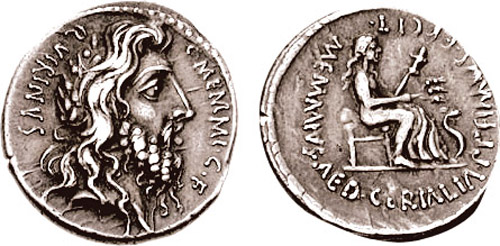
Fig. 1.16. Quirinus who was the deified Romulus, who in Roman mythology was the founder and first king of Rome. Romulus (Armilus) is the jewish antichrist. A link can be established between Quirinus and Esus. In Proto-Celtic, the word “Kwerynos” means “lord” exactly like Kyrios in ancient Greek, and is related to the Etruscan “Kuris” and the Roman “Quirinus”. Quirinus then can potentially translate to “Deified Lord” or “Lord Esus” in the context of Celtic and Etruscan mythology. In Plutarch’s biography of Romulus we are told he was the son of god, born of a virgin (Rhea Silvia, a Vestal Virgin); an attempt is made to kill him as a baby, and he is saved, and raised by a poor family, becoming a lowly shepherd; then as a man he becomes beloved by the people, hailed as king, and killed by the conniving elite; then he rises from the dead, appears to a friend to tell the good news to his people, and ascends to heaven to rule from on high. Just like Esus and Jesus.
So, Talmudic jews who were hiding out in the Himyarite Kingdom after Emperor Hadrian kicked them out of judea basically just cut-and-pasted from one of the Bosphoran/Roman imperial cults of the time and infused a slave morality into it. Getting people to abandon their religons for a new one is an almost impossible task, so instead, through religious syncretism and intertextuality, creating a new sect of an established religion makes it easier for a population to adapt. Julius Caesar aka Asander of Bosphorus or one of his successors in the Bosphoran imperial cult (King Izates Monobazus or Tiberius Julius Sauromates II) was replaced with Simon bar Kokhba. This became modern Christianity.
This conspiracy was so sophisticated that not only did they rewrite the imperial cult, but they rewrote history to align with their psy-op. Josephus’s (Tiberius Julius Alexander aka Emperor Nerva) works were rewritten by Rabbi Akiva’s students under the alias Hegesippus. The book ‘The Antiquities of the Jews’ then became a pseudo-epigraphical work (of propaganda) that was backdated to make christianity look legitimate in the same way that the ‘Letter of Aristeas’ was backdated to exaggerate the age of the Septuagint. I would even hazard a guess that this group was responsible for burining down the Library of Alexandria which resulted in the loss of all recorded history up until that point so that they could cover up the tracks of their psy-op religion.
Endnotes (Chapter 8)
(a) Marcion of Sinope aka Markianos of Alexandria grew up in the Attis-Sabazios cult on Anatolia before traveling to Judea to study under rabbi Akiva and finally to Alexandria at the Alexandrian School.
(b) There was a Marcus who founded the Marcosian Gnostic sect. He was a teacher of Bishop Irenaeus and a friend of Clement of Alexandria. Was he also Marcion of Sinope aka Markianos of Alexandria? (https://en.wikipedia.org/wiki/Marcus_%28Marcosian%29). St. Jerome in “Against Jovinian” describes Mark as a disciple of the Gnostic teacher Basilides. Here is a list of “Marks” who were active around the same time: Mark, the Evangelist, John Mark, Mark of Apollonias, Markianos of Alexandria, Mahalia, Marcus of Jerusalem, Marcus Pompeius, Marcus Annaeus Lucanus, Marcus the Magician, Marcion of Sinope, Marcus the Marcosian. Mark of Apollonias, John Mark, Mark the cousin of Barnabas, and Mark the Apostle are considered to be the same person by historians, so it is conceivable that all these “Marks” were the same person.
(c) Yohai is a nickname for Yochai. The name Yochai means ‘YHWAH is gracious’ from the Hebrew word Yochanan sometimes transcribed as Johanan. Was he also Johanan the Alexandrian? This would place him in Alexandria at the same time as Markianos of Alexandria.
(d) Quintus Tineius Sacerdos, the brother of Quintus Tinnius Rufus, was the governor of Pontus in Anatolia, so the family likely derived from there. Pilate means the temperament of a warrior I.e., famously temperamental. That’s where the name Pontius Pilate comes from.
Appendix A: The Symbol of the Cross
The symbol of the cross, Celtic cross/high cross/sun cross/solar wheel, et.al., which predates christianity by thousands of years (Callanish Stones. Wikipedia, https://en.wikipedia.org/wiki/Callanish_Stones [link]), was a prominent symbol in ancient Europe. The circle is a sunwheel that together with the cross served as a sundial that had markings to track the time, date, and lunar and agricultural cycles. Also, in portable form it was a sundial clock and compass. Although not a religious symbol, as they were astronomical tools, every city in ancient Europe would have had a large cross raised at its center in the same way that every city today has a clock tower at it’s center. So you can see how christianity spread throughout Europe, through subversion. Most Europeans must have thought that christianity was simply the same relgion that they were already worshiping, and because of widespread illiteracy at the time, they had no idea what garbage was inside the bible.
Appendix B: How did Christianity spread?
Vespasian and his sons Titus and Domitian brought 100,000 jewish “slaves” to Rome (Josephus, Jewish War vi, 9) 13. It seems likely that the 100,000 jewish “slaves” joined the jews that were already in Rome and they became the early church missionaries and profited from selling this religion to the slaves and exploited classes.
Further reading
A Forgery of Our Own (1991) by Revilo P. Oliver [link] (short article where professor Revilo P. Oliver points the finger at Rabbi Akiva as being the center piece of the conspiracy to create a psy-op religion to subjugte the Romans)
The Origins of Christianity (1994) by Revilo P. Oliver [link]
Reflections on the Christ Myth (1994) by Revilo P. Oliver [link]
Cleopatra to Christ (2010) by Ralph Ellis [link] (reveals that the biblical Jesus was based on King Izates of Adiabene who was directly descended from Cleopatra VII)
Following Philo to Pallas (the Freedman): The Most Powerful Man in First Century Rome, also known as Goddess (the Mother) (2019) by P.J. Gott [link] (reveals that Philo of Alexandria was a pen-name for Cleopatra of Mauretania who was married to her brother Alexander (grandson of King Herod)/Ptolemy of Mauretania, therefore, she was the mother of Tiberius Julius Alexander/Arrius Piso. Also, that she was Claudius and Nero’s secretary Pallas and Vespasian’s first cousin and mistress Antonia Caenis.)
Magdalene’s Men. The historic identities of the many men in Mary Magdalene’s life. by P.J Gott [link] (reference guide to the many aliases of Alexander (grandson of King Herod) aka Gaius Julius Alexander, Herodian Prince of Judaea aka Alexander Lysimachus aka Alexander the Alabarch aka Ptolemy (Alexander) bar Menneus aka Ptolemy of Mauretania aka Phraates V aka Monobazus I King of Adiabene, as well as his sister wife Cleopatra (Thea Philopator) of Mauretania aka Cleopatra IX aka Pythodorida Philometor aka Helene aka Drusilla of Mauretania aka Julia Ourania of Parthia aka *“Philo of Alexandria“, and their two sons Tiberius Julius Alexander and Marcus Julius Alexander. Note: Asander of Bosphorus = Julius Caesar, Dynamis = Cleopatra, Mark Antony = King Herod, so that chart confuses some of their aliases with those of Cleopatra and Mark Antony’s grandchildren, but it was my starting point to understanding the many aliases this family used*)
The Royal Ancestry Of The Roman Emperor Vespasian (2021) by Henry Davis [link] (this article proves that Vespasian descended from King Herod. Once I realized that King Herod was Mark Antony’s regional alias then all the pieces fell into place)
Footnotes
See: “History: Fiction or Science? Russia. Britain. Byzantium. Rome. New Chronology Vol.IV” (2008) by Anatoly T. Fomenko, “Jesus Among the Julio-Claudians” (2017) by Charles N. Pope ‘[link], and “How Fake Is Roman Antiquity?” https://www.unz.com/article/how-fake-is-roman-antiquity [link] for a few authors who make the claim that the “first Rome” was based out of Anatolia. I subscribe to this theory as well. The Latin language likely derives from the Dacian language which was spoken by the Thracians and Phrygians who hailed from the region of modern Romania. Also, the word Byzantine is a modern invention and the area of modern Byzantine (modern-day Istanbul) was once called “Basileía tôn Rhômaíôn” (“Kingdom of the Romans”), the people of that region called themsevles Rhōmaîoi (Romans), and they hailed from Romania (meaning Romanus, or Roman). Most of the “new History” that we accept as fact today was created by the Church Fathers, Jesuits (including all non-European history), and Joseph Justus Scaliger. –Sir Isaac Newton, in his book “The Chronology of Ancient Kingdoms Amended” (1728), claimed that 711 years were added to our calender, and that history was retrofitted to the bible. Anatoly Fomenko increased this number to 1000 years in his books. Anatoly Fomenko claims that all of chronology rests on one guy, Joseph Scaliger (Scaligerian Chronology), the same guy is credited with re-descovery of 80% of the ancient authors and literature, most of the time on demand. Anatoly Fomenko also makes several other controversial claims in his work, specifically that Charlemagne was not a real person, but one of the phantom individuals Catholic Church made up to fill in their phantom 1000 years and Charlemagne is based on a real-life man known as Odoacer. Plato and Gemistus Plethon were one and the same person. Genghis Khan and Attila The Hun were the same person. The Black Plague / Great Plague / Black Death / Bubonic Plague (it’s a copy to fill in the phantom 1000 years of supposed “Dark Ages”) is exactly the same event as the Justinian Plague. The Trojan War and the Crusades were the same conflict. Also, that there were multiple “Romes” and the major one was based out of Anatolia, in an area that is modern Istanbul. The last point I independently confirmed. Julius Caesar = Asander of Bosphorus, and all early Christianity traces back to to the Bosphorus. ↩
Julius Caesar was his title (Caesar is etymologically similar to the Indo-Aryan word for “king” and Julius (Iulius) is similar to both (I)Jupiter and to the Indo-Aryan word for “sun”). Julius Caesar was deified in two religions: in the Flamen Dialis cult (Dialis is related to Diespiter, an Old Latin form of the name Jupiter) which made him the claimed son of (I)Jupiter (There was no letter J in Latin and (I)Jupiter is the Roman equivalent of Zeus and they both derive from the Aryan allfather Dyeus Pter which translates to Sky Father. The name Zeus comes from the pronunciation of “Dyeus”, and (I)Jupiter comes from the pronunciation of “Dyeus Pter” -> Diespiter -> Iupiter), and he was deified posthumously in the Divus Iulius cult (Divus is synonymous to Dyeus, and as aforemented, Iulius derives from (I)Jupiter). He had a claimed divine birth, was put on trial, betrayed, sacrificed, and was a pontifex maximus (high priest) in his religion. –A statue from the Bosporan Kingdom, dated to Asander’s reign (ca. 47–17 BCE) refers to Asander/Asandros as Asandros Philoromaios Soter and gives him the title “King of Kings”. So he was a “Soter”/Christ. Source: Corpus Inscriptionum Regni Bosporani (CIRB 30) https://www.researchgate.net/publication/333149205_CIRB_30_Asandros_and_Dynamis_CIRB_Corpus_Inscriptionum_Regni_Bospori. ↩
“The Gospel of Jesus’ Wife Papyrus.” The Nazarene Way, https://www.thenazareneway.com/Gospel%20of%20Jesus%20Wife%20Papyrus.htm.[link] –Asander and Julius Caesar both used the Nike crescent. Nike is the goddess who personifies victory in Greek mythology. https://www.britishmuseum.org/collection/object/C_1987-0649-62 [link] https://www.britishmuseum.org/collection/object/C_RPK-p137A-1-Nic [link] ↩
A coin of Dynamis, queen of Bosphorus, where she is depicted as Aphrodite “Urania”: https://www.forumancientcoins.com/gallery/displayimage.php?album=880&pid=2383#top_display_media [link]. Dynamis carried the title Ouriana, refering to Aphrodite Urania (“heavenly Aphrodite”), the Greek godess. Cleopatra also depicted herself as Aphrodite. Cleopatra’s daughter Cleopatra Selene II was also Queen Thea Muse Ourania. –Another Dynamis coin depicting a Star and Crescent which was also the symbol of the royal house of Adiabene and later became a prominent symbol in Islam: https://rpc.ashmus.ox.ac.uk/coins/1/1864 [link]. In ancient greek mythology Selene (meaning moon) is the goddess and personification of the Moon. Her symbol is the cresent mon. Cleopatra’s daughter, Cleopatra Selene II of Mauretania, coins also depict a star and crescent. –Julius Caesar also used the star and crescent symbol: https://www.accla.org/actaaccla/juliuscaesar.html [link] https://auctions.stacksbowers.com/lots/view/3-US7SY/julius-caesar-ar-denarius-392-gms-rome-mint-l-aemilius-buca-moneyer-lifetime-issue-44-bc-ngc-au-strike-45-surface-45-e [link] –Juba II (Cleopatra VII and Mark Antony’s son) also used the star and crescent symbol: https://www.vcoins.com/en/stores/den_of_antiquity/48/product/mauretania_juba_ii_ar_denarius/1952816/Default.aspx [link] ↩
His name alludes to the Mithras cult. Mithraism was spread by Tiridates of Armenia (alias of Alexander, grandson of King Herod, Mithridates Chrestus descendant?) after Rome’s defeat of Parthia around 53 AD as a slave-morality religion to subjugate the Parthians. Mithras is inspired from Zoroastrianism, the religion of the Persians/Parthians, but Mithras is the same as Sabazios. It’s a solar son deity, a Jupiter (Mithridates Chrestus’s descendant carried the title Monobazus aka Manu-Sabazios). The Mithras cult has many similarities to Christianity; Mithras was born of a virgin, Mithras’ birth was celebrated on December 25, Mithras was considered a savior and redeemer, etc., although all these traits are “de jure” of saviors in ancient religions, probably because they all came from the “Alexandrian School” in Egypt. The Serapis cult, Gnosticism, Valentinianism, Christianity, Hermeticism, Mithraism, Manichaeism, Mandaeism, and many other religions came from the Alexandrian School. The Sibylline Oracles were the blueprint for these religions./ ↩
Jesus ben Fabus who was Isa Amen (Jesus Amen) of Rev. iii. 14 who was also Amyntas (Amen(tas)) of Galatia who was also Amyntas Nikator (the name Fabus may have been distorted by Josephus from Jesus ben Bagus. Amyntas was the son of Bogitarus. In Persian “Bagus” means god. “Boga” in Persian also means god and in the name Adobogiona “Bog-“ means god in Celtic. In Latin Nikator translates tro Invictus). His palace at Iśauria reveals his name as Iśa. (See: Jesus Christ Was Amyntas of Galatia (2010) by Ranajit Pal [link]) ↩
The name Herod likely derives from the amalgamation of Horus and Hercules (Herakles in Greek). Mark Antony claimed descent from Hercules and declared himself an incarnation of Horus. Herod became king of judaea around the time of Mark Antony’s “suicide”. This is typical for these elites, they would kill off one character and then assume another one in a different location as if they were actors in a play.\ –The Shekel of Tyre that King Herod minted depicts Mark Antony and an image of Hercules: https://www.forumancientcoins.com/numiswiki/view.asp?key=tyrian%20shekels [link]. Herod also built a number of temples and shrines dedicated to Hercules, including one in Beirut and another in Tyre. He also depicted himself as Hercules in his Herodian Cult. King Herod’s son, Herod Antipas, has the same name as Mark Antony’s son, Antyllus, King Herod’s other son Antipater was Iullus Antonius, Mark Antony’s son with Fulvia. The wife of Iullus Antonius is called Marcella daughter of Octavian/Augustus’ sister Octavia. Fulvia and Antony also are said to have had two daughters, Antonia I and Antonia II. Caligula and Claudius were descendants of Antonia I. Probably Antonia I and/or II was the sister of Herod the Great called Salome. Probably there is also a connection between “Costabar” husband of Salome and the Roman “Ahenobarbus” who married Antonia I.\ –Mark Antony (King Herod) = Tiberius Claudius Nero. The way to make this connection is through the equivalence of Doris the first wife of Herod the Great and Livia Drusilla the second wife of Octavius/Caesar Augustus. Augustus was first married to Scribonia, but not happily. In 39 BC she gave birth to a daughter, Julia, but was divorced by Augustus. In the same year he became engaged to Livia Drusilla, who was at the time pregnant, not by Augustus but by her own first husband. That husband was Tiberius Claudius Nero, praetor of 41 BC and son of another Tiberius Claudius Nero, praetor of 62 BC. Tiberius Claudius Nero and Livia Drusilla’s son was emperor Tiberius Julius Caesar Augustus. ↩
Jesus ben Gamala/Gamaliel aka Jesus ben Sapphias was also King Izas Ma’nu (Jesus Emmanuel) Monobazus of Adiabene aka Yeshua Cleopatros (Cantheras/Panthera) ben Josephus bar Menneus aka Ptolemy aka Yakov Zu Tolomoy. (See: Jesus, King of Edessa (2012) by Ralph Ellis [link]). King Izates of Monobazus was married to the sister of Dynamis’s mother.\ –Cleopatros in Hebrew is QLPTRS and was shortened on inscriptions to QTRS or Katros, later mistakenly recorded as Cantheras. So the Jews for derogatory reasons called it as Panthera. ie. Jesus Panthera. ↩
Tiridates II, King of Parthia.” Geni, https://www.geni.com/people/Tiridates-II-king-of-Parthia/6000000019000945876 [link] ↩
Davis, Henry. “The Royal Ancestry of the Roman Emperor Vespasian.” Medium, https://henrydavis-cc.medium.com/the-royal-ancestry-of-the-roman-emperor-vespasian-72e144335299. [link] ↩
Davis, Henry. “The Royal Ancestry of the Roman Emperor Vespasian.” Medium, https://henrydavis-cc.medium.com/the-royal-ancestry-of-the-roman-emperor-vespasian-72e144335299. [link] ↩
Josephus, Jewish War vi, 9 –How Yahweh Conquered Rome. Laurent Guyénot. https://www.unz.com/article/how-yahweh-conquered-rome/ ↩